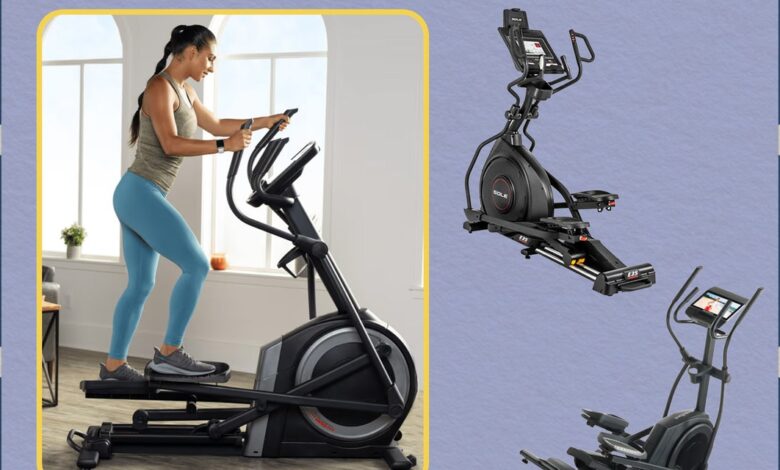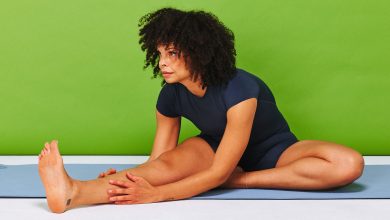The Best Ellipticals for a Low-Impact Workout

Fyt personal trainer Carla Baccio recommends making a list of your must-have features before shopping—and we’d recommend perusing our full elliptical buying guide too.
Built-in programming
As far as preloaded workout programs go, Waetzig says a good elliptical should have hills, intervals, and a manual setting, at the very least. Baccio notes that it’s also nice to have a machine that tracks your steps and offers heart rate monitoring.
Handles
Collins recommends considering the handles. Stationary ones make it easier to get on and off the machine safely, while moveable handles can help you get in a more full-body workout if you really focus on pushing and pulling them.
App connectivity
Waetzig says ellipticals for home use don’t necessarily need many bells and whistles. When you have access to Netflix and the rest of your home streaming services, you might not need an elliptical with internet connectivity and a huge LCD display, he says as an example. But if you are interested in smart home gym equipment, Waetzig says to seek out machines that are compatible with your fitness tracker. “Finding equipment that can connect to your Apple Watch or Fitbit is a great motivator. Seeing the numbers displayed without breaking your stride really can be an encouraging thing,” he says.
Ellipticals versus treadmills: key differences to consider
Although you can get a great workout on either a treadmill or an elliptical, the latter will put less stress on your joints since you never take your feet off of the pedals. “Personally, I invested in an elliptical before a treadmill because of the option for low-impact cross-training,” Collins says. “It’s a lot easier to get outside to run or find a hill in your neighborhood or jump on a track.”
Dr. Lin also points out that even though you can walk or run on a treadmill, the mechanics of the belt moving below you don’t exactly mimic what it takes to walk or run outside. “You’re taking that belt underneath your foot and pulling it, whereas when you’re on land, you’re pushing the ground instead of pulling. [It’s] a little different action,” he says. However, most ellipticals require you to push the pedals, which gets the glutes and hamstrings firing in a healthy way.
To simulate a running motion on an elliptical even more, Collins recommends letting go of the handles (as long as you feel safe enough), and swinging your arms like you would when you’re running. “It’s a little bit more natural,” she says, adding that this option can be especially useful for runners who “are trying to use it for cross-training or are injured and really want to focus on keeping their running motion going.”
Choosing the right resistance level on an elliptical
It can be tough to figure out the exact resistance to use on an elliptical since the levels vary from machine to machine—Collins points out that you can’t just plug in 8 miles an hour and know the exact intensity like you would on a treadmill. Instead, you have to carefully tune in to your effort level.
The “right resistance” ultimately depends on the kind of cardio workout you’re after. For general aerobic conditioning, Dr. Lin suggests aiming for an effort level that’s around a moderate four or five on a scale of one to 10. For a HIIT workout, Collins recommends alternating between one minute hard and one minute easy, 10 times. During the hard minute, try to hit what she calls your “work pace” (”feel like you’re pushing yourself, but it’s not an all-out sprint,” she says), then during the easy minute, decrease the resistance and your speed enough to let your body recover and get your breath back under control.
FAQs
We have answers to some of the most common questions about picking the best elliptical for your home.
How much does an elliptical cost?
The prices of ellipticals range widely. Some budget-friendly options, like the Sunny Health and Fitness Elliptical Trainer, are less than $400. But if you want a high-end, commercial-grade elliptical with top-notch technology, you’ll be paying closer to $2,000.
What muscles does the elliptical work?
The exact muscles that get worked when you’re training on an elliptical depends somewhat on the design and settings on the machine, such as the stride length, resistance, and incline, and whether it includes moving handles, which will engage your upper body. But generally, Collins says the calves, quads, hamstrings, and glutes are activated. “When you’re really grinding through a hard interval, I would say you’re engaging your core,” she adds. And if you’re pushing handles, your biceps, shoulders, and chest can get a workout too.
Is an elliptical better than cycling?
Although Dr. Lin says cycling is a great way to get your heart rate up, an elliptical can give you more functional fitness that better translates to daily life for many folks, since you stand on it upright. “Most of us sit for a living, right?” Kinney-Woods adds, pointing out that on a bike, folks who spend their days at a desk can end up remaining in that hunched-shoulders, flexed lower back position during their workouts. Switching to an upright posture, if it’s accessible to you, can help reduce back and neck pain and improve your balance over time. It’s also easier to hit more muscle groups on an elliptical. “You’re getting that full body instead of just working your lower body,” Collins says. (Though of course you could always add dumbbells to a cycling workout.)



